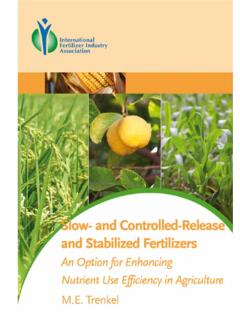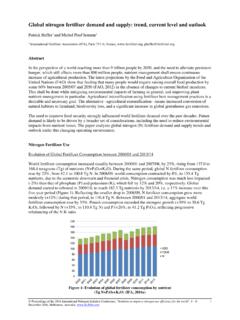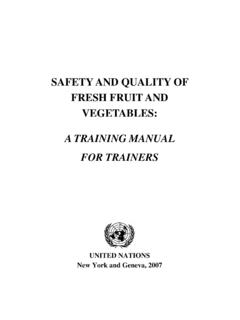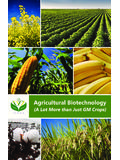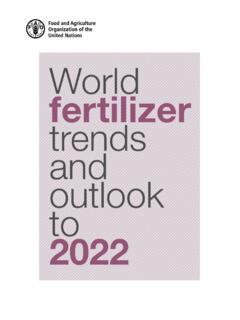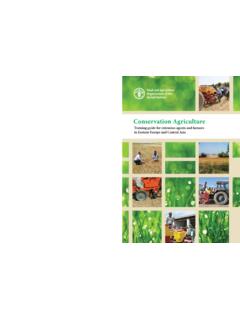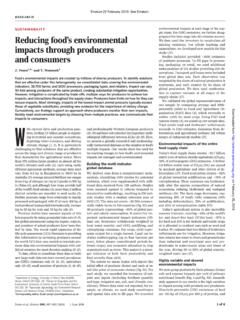Transcription of Nutrient/fertilizer use efficiency: measurement, current ...
1 1 Chapter 1. Nutrient/fertilizer use efficiency: measurement, current situation and trends Paul Fixen1, Frank Brentrup2, Tom Bruulsema3, Fernando Garcia4, Rob Norton5, and Shamie Zingore6 AbstractNutrient use efficiency (NUE) is a critically important concept in the evaluation of crop production systems. It can be greatly impacted by fertilizer management as well as by soil- and plant-water management. The objective of nutrient use is to increase the overall performance of cropping systems by providing economically optimum nourishment to the crop while minimizing nutrient losses from the field. NUE addresses some but not all aspects of that performance. Therefore, system optimization goals necessarily include overall productivity as well as NUE.
2 The most appropriate expression of NUE is determined by the question being asked and often by the spatial or temporal scale of interest for which reliable data are available. In this chapter we suggest typical NUE levels for cereal crops when recommended practices are employed; however, such benchmarks are best set locally within the appropriate cropping system, soil, climate and management context. Global temporal trends in NUE vary by region. For N, P and K, partial nutrient balance (ratio of nutrients removed by crop harvest to fertilizer nutrients applied) and partial factor productivity (crop production per unit of nutrient applied) for Africa, North America, Europe, and the EU-15 are trending upwards, while in Latin America, India, and China they are trending downwards.
3 Though these global regions can be divided into two groups based on temporal trends, great variability exists in factors behind the trends within each group. Numerous management and environmental factors, including plant water status, interact to influence NUE. In similar fashion, plant nutrient status can markedly influence water use efficiency. These relationships are covered in detail in other chapters of this International Plant Nutrition Institute, 2301 Research Park Way, Suite 126, Brookings, SD 57006 ( )2 Yara Research Centre Hanninghof, Hanningof 35, D-48249 D lmen (Germany)3 International Plant Nutrition Institute, 18 Maplewood Drive, Guelph, ON N1G1L8 (Canada)4 International Plant Nutrition Institute, Av.
4 Santa Fe 910, (B1641 ABO) Acassuso - Buenos Aires (Argentina)5 International Plant Nutrition Institute, 54 Florence St., Horsham, Victoria 3400 (Australia)6 International Plant Nutrition Institute, C/O IFDC - East & So Africa Div., PO Box 30772 Nairobi 00100 (Kenya)2 The Concept and Importance of NUEM eeting societal demand for food is a global challenge as recent estimates indicate that global crop demand will increase by 100 to 110% from 2005 to 2050 (Tilman et al., 2011). Others have estimated that the world will need 60% more cereal production between 2000 and 2050 (FAO, 2009), while others predict food demand will double within 30 years (Glenn et al.)
5 , 2008), equivalent to maintaining a proportional rate of increase of more than per year. Sustainably meeting such demand is a huge challenge, especially when compared to historical cereal yield trends which have been linear for nearly half a century with slopes equal to only to of 2007 yields (FAO, 2009). Improving NUE and improving water use efficiency (WUE) have been listed among today s most critical and daunting research issues (Thompson, 2012). NUE is a critically important concept for evaluating crop production systems and can be greatly impacted by fertilizer management as well as soil- and plant-water relationships.
6 NUE indicates the potential for nutrient losses to the environment from cropping systems as managers strive to meet the increasing societal demand for food, fiber and fuel. NUE measures are not measures of nutrient loss since nutrients can be retained in soil, and systems with relatively low NUE may not necessarily be harmful to the environment, while those with high NUE may not be harmless. We will provide examples of these situations later in the chapter that illustrate why interpretation of NUE measurements must be done within a known context. Sustainable nutrient management must be both efficient and effective to deliver anticipated economic, social, and environmental benefits.
7 As the cost of nutrients climb, profitable use puts increased emphasis on high efficiency, and the greater nutrient amounts that higher yielding crops remove means that more nutrient inputs will likely be needed and at risk of loss from the system. Providing society with a sufficient quantity and quality of food at an affordable price requires that costs of production remain relatively low while productivity increases to meet projected demand. Therefore, both productivity and NUE must increase. These factors have spurred efforts by the fertilizer industry to promote approaches to fertilizer best management practices such as 4R Nutrient Stewardship, which is focused on application of the right nutrient source, at the right rate, in the right place and at the right time (IPNI, 2012b) or the Fertilizer Product Stewardship Program ( fertilizers Europe, 2011).
8 These approaches consider economic, social, and environmental dimensions essential to sustainable agricultural systems and therefore provide an appropriate context for specific NUE indicators. NUE appears on the surface to be a simple term. However, a meaningful and operational definition has considerable complexity due to the number of potential nutrient sources (soil, fertilizer, manure, atmosphere (aerial deposition), etc.), and the multitude of factors influencing crop nutrient demand (crop management, genetics, weather). The concept is further stressed by variation in intended use of NUE expressions and because those expressions are limited to data available rather than the data most appropriate to the interpretation.
9 1. Nutrient/fertilizer use efficiency: measurement, current situation and trends3 The Objective of Nutrient Use and Nutrient Use EfficiencyThe objective of nutrient use is to increase the overall performance of cropping systems by providing economically optimum nourishment to the crop while minimizing nutrient losses from the field and supporting agricultural system sustainability through contributions to soil fertility or other soil quality components. NUE addresses some but not all aspects of that performance (Mikkelsen et al., 2012). The most valuable NUE improvements are those contributing most to overall cropping system performance. Therefore, management practices that improve NUE without reducing productivity or the potential for future productivity increases are likely to be most valuable.
10 If the pursuit of improved NUE impairs current or future productivity, the need for cropping fragile lands will likely increase. Fragile lands usually support systems with lower NUE that also use water less efficiently. At the same time, as nutrient rates increase towards an optimum, productivity continues to increase but at a decreasing rate, and NUE typically declines (Barbieri et al., 2008). The extent of the decline will be determined by source, time, and place factors, other cultural practices, as well as soil and climatic conditions. Intended Use and Available Data for NUE ExpressionsThe most appropriate NUE expression is determined by the question being asked and often by the spatial or temporal scale of primary interest for which reliable data are available.
